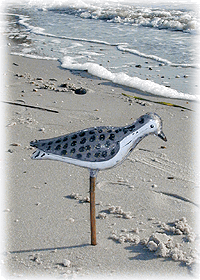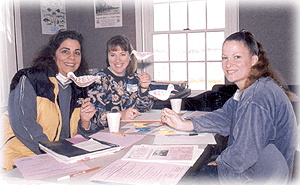 |
|
|||
Objectives
Cardboard and/or mat board (or wood) Popsicle sticks Tape and/or glue Bird identification books Scissors or utility knife Making Connections Background Shorebird decoys, also called “snipe stools” hold a special appeal. These are the decoys intended to lure the different kinds of plovers, sandpipers, and their variously named relatives. These decoys are valued not only for their aesthetic attributes, but they are also valued for their relative scarcity and assumed greater antiquity. The last open season on shorebirds other than upland species was in 1927, although at an earlier date complete or partial bans on interstate traffic of game birds and an increasing scarcity of many species due to hunting and nest robbing had put a crimp in snipe gunning. Shorebirds come at a time in spring after most of the winter ducks have left and return again in late summer and early fall before waterfowl have appeared en masse. Thus, they provided game for the ardent hunter when other legitimate quarries were scarce. They were also hunted for market, although their gustatory (taste) appeal is likely to vary both seasonally and Shorebirds are found in New Jersey mainly as transients. Among the few exceptions is the willet, a species that breeds locally. It seems to be recovering in numbers and has spread from a limited refuge on the Delaware Bay shore to become common again on parts of the coast. The other New Jersey nesting species is the piping plover, a statewide and nationally endangered species. The piping plover is an open beach nester and habitat destruction and use continues to be the major cause of decreased numbers of these birds. Two other sandpipers, the so-called upland plover and the woodchuck, also breed in the state, but these upland birds were not hunted with decoys. Most other shorebirds are here but briefly while en route between summer breeding grounds and winter quarters. May is the prime month for them in spring migration, although the time for the different kinds extends from late April to early June. Mud flats, marshy pools and banks, and sand bars rich in small burrowing and wavecast animals are prime shorebird habitats. Some birds, notably the sanderling, favor the oceanfront itself. In all these places, mixed flocks may be seen while the tide is down, feeding together with busy probings and frantic rushes along the foam line. Species identification of the shorebird decoys is difficult at best. In their spring finery, the different kinds of sandpipers and plovers are nicely differentiated, but the fall plumages are another matter. At that time, identification often presents a stiff challenge to bird-watchers. The baymen, excellent practicing naturalists and observers though they were, did not aspire to great precision in painting fall plumages on their decoys. Nor was there a need for it, since these birds have a reputation for being easily decoyed.
Collect the appropriate materials needed to make the shorebird decoys. Suggestion: Grades 4 to 6 use cardboard or mat board - for older students, include the shop teacher and have students cut decoys from wood. Warm Up Have the students bring in pictures or samples of animal carvings. Discuss whether the carvings are realistic or a general impression of the animal. Discuss why people might carve an animal (utilitarian, hobby, make a living, etc.) Compare types of materials that people use to make their carvings. The Activity
Students prepare a short poem, description, notes about their shorebird and share them with the class. Action Students could develop and formulate a debate for and against shorebird hunting and hold a mock trial to discuss the issues and opinions about this topic. A mud flat/saltmarsh habitat diorama could be created as a bulletin board or mural and all of the “decoys” displayed in their natural habitat. Assessment List three reasons why shorebirds were hunted. List three reasons why hunting was ceased. Extensions Invite a local decoy carver to come into class and speak about their art. Have students interview people that are descendents of carvers, have collections of decoys, etc. Please download the PDF for the complete Lesson Plan packet. Working Decoys of the Jersey Coast and Delaware Valley, by Kenneth L. Gosner 1985, Rosemont Publishing and Printing Corporation |
|||

 Interpreting, identifying, classifying
Interpreting, identifying, classifying Materials
Materials  Procedure
Procedure Wrap Up
Wrap Up